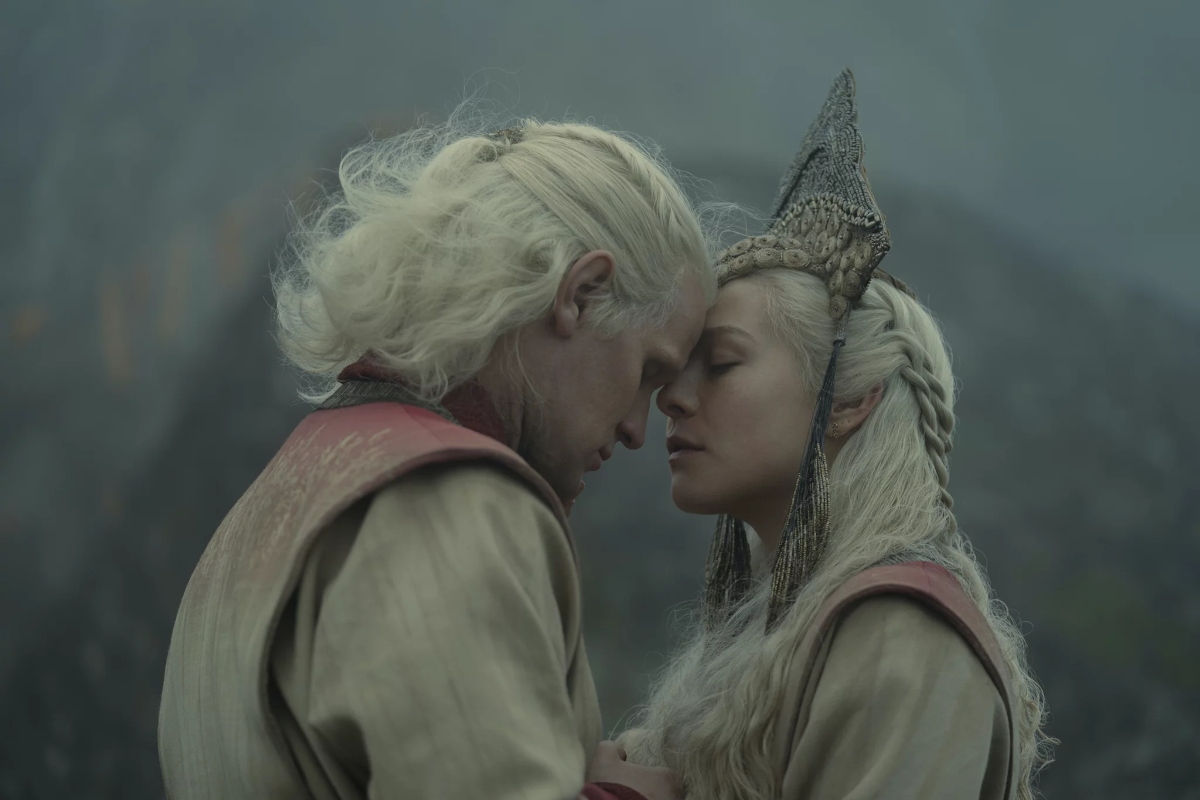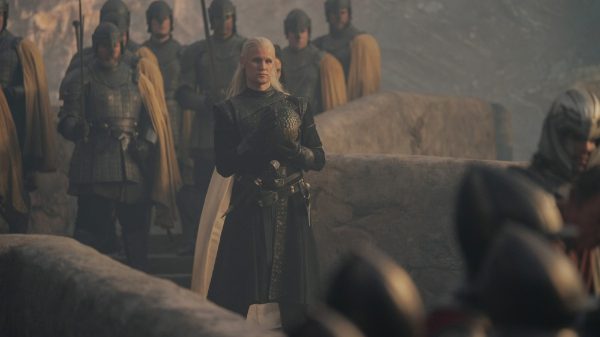The latest episode of House of the Dragon didn’t begin with a time jump, but it sure did have a lot of action. Ranging from dragons to murder, House of the Dragon Episode 7 was packed with events that not only changed the course of this story but also make fans look back at the Game of Thrones lore from the books.
SPOILER ALERT: The night is dark and full of terrors, and the internet is dark and full of spoilers. Consider yourself warned as we’re about to dive into episode 7 of House of the Dragon.
See More: Details you might have missed in House of The Dragon Episode 7
Jerry Springer, but make it Game of Thrones

(Photo courtesy of HBO)
After a fair amount of whiplash from so much time-jumping, we get to catch our breath this week as the action picks up at the funeral of the late Lady Laena Valeryon (Valar Morghulis), after she ended her life with dragonfire in the previous episode.
Episode 7, Driftmark, was the first episode filmed of the season, which is interesting to keep in mind from an acting perspective and as a window into the showrunners’ minds. The events that transpire here are at the core of all the characters, their motivations, and all the events past and all events to come.
The episode is bookended with two long, theatrical scenes, feeling almost more like a stage play than a piece of television. And in the bonus material for the episode, that’s precisely how Miguel Sapochnik explains he approached directing these moments.
The episode is truly action packed, from a funeral to a wedding, with dragon claiming, eye losing, incest, murder, deceit, and the climactic delineation of “greens” versus “blacks” all housed within an hour.
See more: When will ‘Fire & Blood’ Book 2 be released?
Farewell to Miguel Sapochnik

House of the Dragon showrunner & director Miguel Sapochnik
‘Driftmark’ is also the final episode of the Game of Thrones franchise that we’ll see directed by powerhouse Miguel Sapochnik. He has been one of the creative foundations of Game of Thrones and House of the Dragon, not just as showrunner of the latter, but from directing such episodes as ‘Hardhome’, ‘The Battle of the Bastards’, and ‘The Long Night.’
One divisive directorial choice Sapochnik has been guilty of in the past is his use of cinematic darkness. In Thrones, audiences lamented that ‘The Long Night’ was simply too dark, though the makers used that in the episode as a tool to heighten suspense.
In this most recent episode of House of the Dragons, large portions of the action took place in near-dark, creating backlash from some audiences.
About this creative decision, Sapochnik said, “It made sense that this was the last hope humanity has, the last beacon of light, and from the perspective of where we needed the story to go – which was to reach a surreal, chaotic climax – we needed an environment that was friendly to that. So all the reasons for doing it were there, and nobody sat there and wondered if it was gonna be too dark.”
We can say that two critical truths exist at once: these scenes are too dark to clearly see what was going on, and it was for an uncomfortably extended period of time. But at the same time, the director took an artistic risk from a solidly methodical thought process. And even if it didn’t entirely work, it did create an engulfing mood for the intimacy between Rhaenyra and Daemon.
Which brings us to…
Rhaenyra & Daemon, Blood of my Blood

(Photo courtesy of HBO)
As I foretold in last week’s review, Emma D’Arcy and Matt Smith absolutely shine together. Their chemistry is – dare I say – on fire. And now their characters, after so long apart and after everything they’ve been through, have reunited. Moreso, they have bound themselves together, in the flesh and in marriage vow.
Game of Thrones has been an oddly strong force in normalizing incest within our cultural conversation. Cersei & Jaime opened this pandora’s box for us, but Rhaenyra and Daemon are taking it to a whole new level … by making us ship them.
On the one hand, we know that incest is repulsive, on a basic scientific level. We feel this innately, and the world considers incest taboo. On the other hand, we know that Targaryens have blood magic that they must pass down in order to ensure their connection with the dragons. Talking about the purity of bloodlines should always raise an alarm, but in this case, we can also concede that, well, dragons are worth it.
Perhaps this Targaryen bias is why audiences are largely much quicker to warm up to the thought of Rhaenyra & Daemon than in previous cases of Westerosi incest.
More: The biggest moments from House of the Dragon Episode 7
And so, acknowledging the awkwardness of the incestuous dynamic, let us also pause to appreciate how perfect of a match their personalities are.
Problematic in a different way (the huge age gap between the two) was their previous exploits and hot-and-heavy flirtations. But they’ve both grown up and settled into who they are as people. More mature, they are a perfect example of a relationship that needed to wait in order to work.
Their union culminated in verbal intimacy and moonlit lovemaking (It is almost unfair how erotic the directors have made their love scenes). Their bond has been solidified by the most surprisingly functional Westeros wedding yet – cutting themselves with dragonglass and bonding their blood in a traditionally Targaryen manner.
This show has elevated the game. Rhaenyra & Daemon are a power couple with eyes on the Iron Throne. As they prove with their machinations in freeing Leanor & Rhaenyra from their vows, they are capable of almost anything, especially together.
What could possibly stand up to the combined power of the heir to the throne and the King of the Narrow Sea?
Buy: Funko Pop! House of Dragon – Alicent Hightower
Claiming a Dragon

(Photo courtesy of HBO)
MVP of the episode is an unlikely (and frankly unlikeable) one. Little Aemond Targaryen, whom the other children were making fun of only last week for being the only one without a dragon, decided to take action. In a truly brazen move (and an example of lax parentage and royal security), he risked it all in order to claim the largest dragon currently in existence: Vhagar.
In this case, the atmospheric darkness really worked: Vhagar loomed horrifyingly large compared to this small child. And as she opened her mouth to threaten a reprise of deadly dragonfire, there was a moment where the idea of mortality in the face of hubris was illuminated alongside the screen.
It was satisfying to see a new rider claiming a dragon. It was thrilling to watch the test of the first flight that Vhagar put Aemond through.
Aemond accomplished something incredible. But then he had to go and ruin it all. (Though admittedly, claiming a dragon assumed to be Lady Leana’s daughters’ birthright right after her funeral was a pretty dick move.)
See more: Everything we know about Aemond Targaryen
An eye for an eye leaves the world blind

(Photo courtesy of HBO)
The ensuing violence that erupted between the children, which culminated in Aemond losing an eye (as was foretold by his sister), could be considered the inciting incident for the impending war to come.
True, there have now been years of royal drama festering from the time King Jaehaerys named Viserys the heir to the throne. But with the loss of the eye and the drama that ensues, we see that there is no going back from a truly divided court, all of whom want power, revenge, or the combination of both.
Where we stand, where we go from here

(Photo courtesy of HBO)
Larys Strong, meanwhile, lingers – flagrantly, cartoonishly evil. Like, we get it, the character is evil. But maybe he doesn’t have to be so stereotypically nefarious in his manner? I’m sure his dastardly deeds will delight us in the future. But his predecessors Little Finger and Ramsay Bolton were both so compelling because you didn’t know what they would do next. Larys, instead, seems ready to do the evilest thing that is within his own self-interest at any time.
Alicent continues to be the absolute worst.
In last week’s review, I named Alicent as Westeros’s official Karen. This week, she more than lives up to the title. Still wearing green and carrying a decade-old grudge (if only there were therapists in Westeros), she’s taken it up a notch by demanding the eye of a child, stealing the King’s dagger in front of everyone, brandishing it, and assaulting the heir to the throne.
Look, I’m not denying that life as a woman in Westeros (as in this world) is full of unjust challenges, and the showrunners have done a good job of reminding us every step of the way of the burdens they bear, and which Alicent must shoulder. And feminine anger is deserving of taking up space in a world that stigmatizes it.
But despite the tragedy of her existence and the obligations of her position as queen, Alicent Hightower is not a sympathetic character. Rather, she is a case study in how repressing your own feelings and desires while internalizing a toxic patriarchal system can truly warp a mind.
Rhaenyra’s choice to wed Daemon is as much about the heart as it is about fortifying her position – a wise move. The decision to fake Leanor’s death while allowing him to go free with his lover is a kind one, but also a messy one, which could potentially backfire in the future.
Still, Leanor’s parents don’t know their son still lives. Add to that the already unbearable grief of losing their daughter Leana, this will definitely be fuel to the fire in the war to come.
Buy: A Game of Thrones CATAN Board Game
Names or Blood

(Photo courtesy of HBO)
Next episode, we will experience one more time jump, and arrive at the beginning of the core action of ‘A Dance with Dragons.’
Everyone is out for blood, and with dragons abounding, who will sit on the Iron Throne. Or, seven hells, who will simply survive. Because in the game of thrones (as Otto Hightower expresses his enthusiasm for playing by positively reinforcing Alicent’s cruelty), you either win… or you die.
Read next: House Targaryen’s “Greens” and “Blacks” explained
V Cate (they/them) is a freelance writer, independent artist, magic practitioner, and avid fanboy of all things fantasy and sci-fi.











































